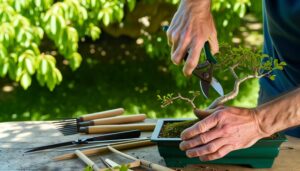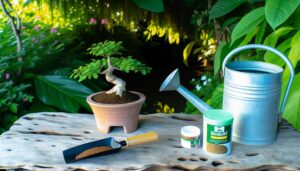What Types of Moss Are Best to Use for Any Bonsai?
Not all moss types are suitable for bonsai due to their varying ecological requirements and potential effects on plant health. Hypnum moss, Dicranum moss, and Sphagnum moss are often preferred for their complementary growth habits and maintenance of ideal soil hydration.
The selection should align with the bonsai species' moisture, light, and temperature needs. While moss offers benefits such as moisture retention, soil stability, and improved aesthetics, it can also cause excessive moisture and attract pests if not carefully managed.
Ensuring proper drainage and regular inspection is vital. For detailed insights, consider evaluating specific moss characteristics and care strategies.

Key Takeaways
- Not all moss types are suitable; select based on bonsai species' ecological needs.
- Ensure the moss chosen has compatible moisture-holding capacity with your bonsai.
- Avoid moss that can outcompete the bonsai for nutrients.
- Check for moss compatibility with light and temperature conditions of the bonsai's environment.
- Regular inspection and proper care are essential to prevent root rot and pest issues.
Types of Moss for Bonsai

There are several types of moss commonly used in bonsai cultivation, each offering unique benefits and aesthetic qualities to the miniature landscape.
Hypnum moss, also known as sheet moss, is widely favored for its robust growth and fine texture, which seamlessly integrates with the bonsai aesthetic.
Dicranum moss, characterized by its upright, tufted appearance, adds a dynamic, three-dimensional aspect to the display.
Sphagnum moss, although not typically used as a surface covering, is invaluable for its superior moisture retention properties and is often employed as an underlayer to maintain ideal soil hydration.
Practical selection of moss type depends on specific bonsai species requirements and desired visual outcomes, making it essential to understand the characteristics and ecological needs of each moss variety.
Benefits of Using Moss
Incorporating moss into bonsai cultivation offers numerous benefits. One advantage is enhanced moisture retention provided by moss acting as a natural mulch. This reduces evapotranspiration rates, maintaining optimal hydration levels for the bonsai's root system. Additionally, moss contributes to soil stability by increasing soil cohesion, minimizing erosion, and maintaining substrate integrity during watering.
Another benefit is the aesthetic enhancement that moss provides. It offers a visually pleasing ground cover that complements the bonsai's miniature landscape, emulating a natural woodland floor. The visual harmony provided by moss can elevate the overall presentation of the bonsai. Notable advantages include:
- Moisture Retention: Moss keeps the soil consistently moist.
- Soil Stability: It helps prevent soil erosion and compaction.
- Aesthetic Enhancement: Moss offers a lush, green ground cover that enhances visual appeal.
These benefits collectively foster a healthier and more attractive bonsai.
Potential Pitfalls

Despite its numerous benefits, the use of moss in bonsai cultivation can present several challenges that need careful management. One primary concern is the potential for excessive moisture retention, which can lead to root rot if not monitored attentively.
Moss can also attract pests such as slugs and fungi, potentially compromising the plant's health. Additionally, certain moss species may outcompete the bonsai for nutrients, leading to nutrient deficiencies.
Another issue is the difficulty in maintaining the appropriate pH balance, as some mosses can acidify the soil. To mitigate these pitfalls, it is important to regularly inspect the bonsai, guarantee proper drainage, and select moss varieties that complement the specific needs of the bonsai species.
Choosing the Right Moss
Selecting the appropriate moss species for bonsai cultivation involves considering factors such as moisture-holding capacity, compatibility with the bonsai species, and environmental conditions. The right choice of moss enhances the aesthetic appeal and promotes a healthy growing environment for the bonsai.
When choosing moss, consider the following:
- Moisture Retention: Opt for moss that holds sufficient moisture to support the bonsai without leading to root rot.
- Compatibility: Guarantee the moss species is compatible with the bonsai's native habitat and growth requirements.
- Environmental Conditions: Select moss that thrives in the same light and temperature conditions as your bonsai.
These criteria guarantee that the moss not only complements the bonsai visually but also supports its physiological needs.
Tips for Moss Care

Maintaining peak moss health requires regular monitoring of moisture levels, light exposure, and nutrient availability to guarantee strong growth and longevity.
Ensuring consistent moisture is paramount; moss should remain damp but not waterlogged. Utilize a fine mist sprayer to maintain humidity without causing root rot.
Light exposure should be diffused; direct sunlight can desiccate moss, whereas low light hinders photosynthesis. A shaded area with indirect light is ideal.
Nutrient needs are minimal; however, occasional application of diluted, balanced fertilizers can promote verdant growth.
Regularly inspect for pests and fungal infections, treating promptly with appropriate biocides.
Conclusion
To sum up, integrating moss into bonsai cultivation provides significant aesthetic and horticultural advantages, but it necessitates careful selection and maintenance.
Importantly, a study revealed that moss presence can enhance soil moisture retention by up to 20%, which is vital for the well-being of bonsai trees.
However, unsuitable moss selection can result in problems like excessive moisture and root rot.
Hence, a prudent selection of moss species, along with meticulous care, is imperative for the best bonsai growth.



